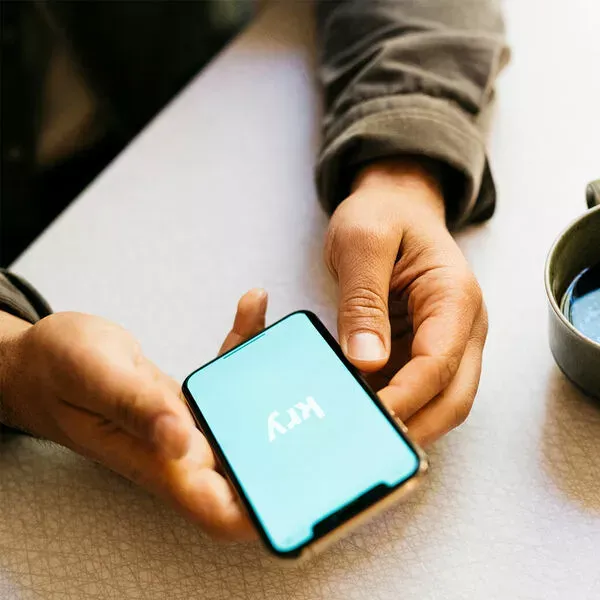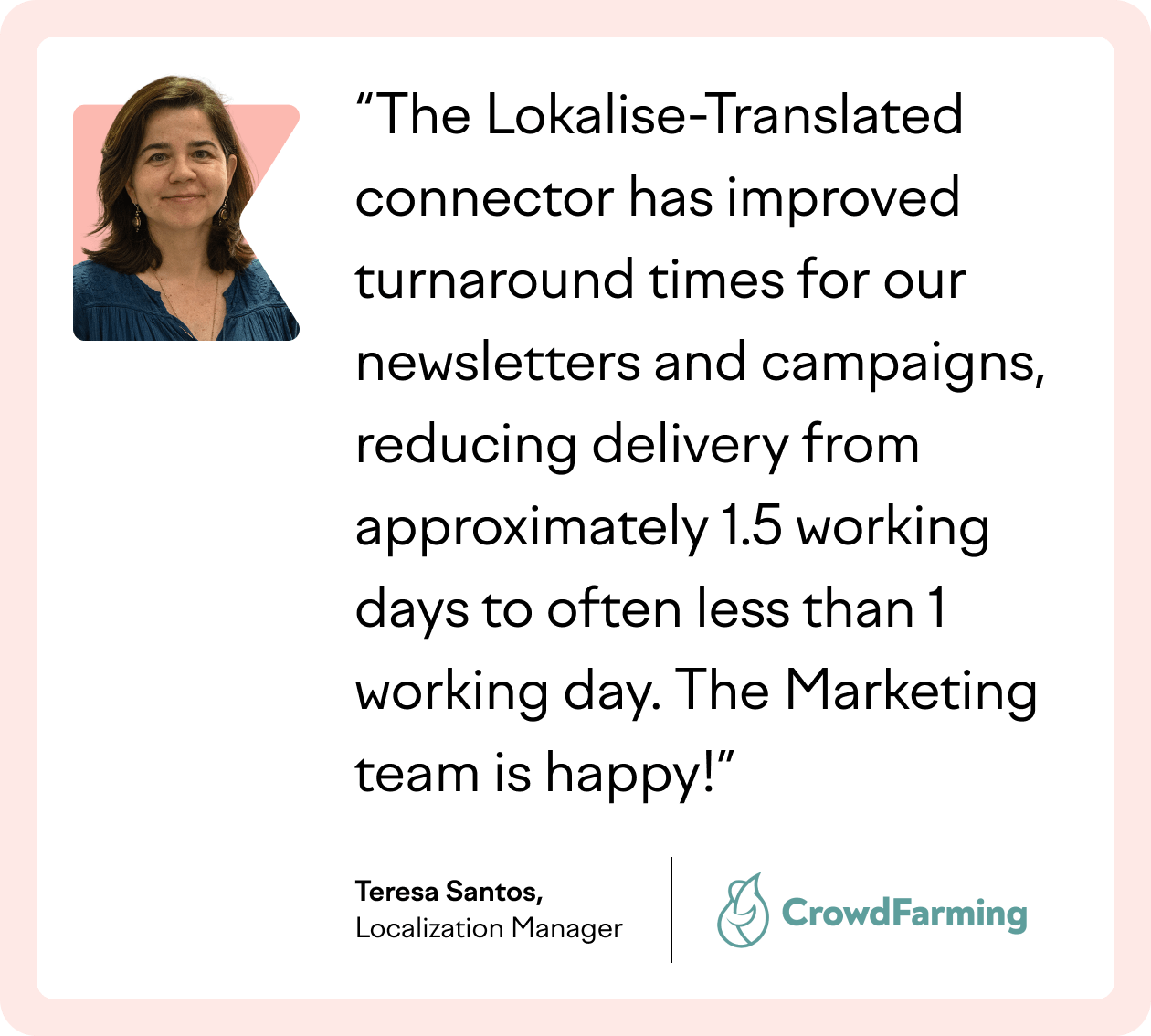3x faster translation turnaround
Successful expansion to 3 more languages
Improved campaign agility
Crowdfarming 🌍 Lokalise: a summary
🧳 The requirement: Scale localization from 4 to 7 languages while eliminating chaotic manual processes that made it impossible to manage translations across operational, regulatory, and transactional business needs.
💡The solution: Centralized localization platform with integrated translation management.
- Seamless integration with existing tools and language service providers
- Centralized content management
- Flexible workflows supporting both internal teams and Translated
- Scalable architecture built to handle rapid language expansion without added complexity
🏅 The results:
- 3x faster translation turnaround (from 1 week to 1.5 days)
- 100% reduction in internal translation resource usage
- Successful expansion to 3 more languages (7 in total)
- Faster, more flexible marketing for produce that spoils quickly
- Translation costs reduce by about 20%
- Sales increased by about 60% in Sweden
About Crowdfarming
CrowdFarming is a platform that connects European farmers directly with consumers throughout Europe, creating a shorter, more accessible, and more sustainable food supply chain. Founded by farmers, CrowdFarming provides producers with the tools to sell directly to the people who eat their food—no middlemen, no unnecessary waste, just genuine connections and better outcomes for everyone.
Challenge: chaotic and manual localization processes made it impossible to scale to 3 more languages
Localization is very important to CrowdFarming since it impacts every stage of the business:
Operational: Produce is available in many different varieties, which change from one country to the next, so names and descriptions need to be adapted
Regulatory: Compliance documents, like labels, allergens, and descriptions of ingredients, which are highly technical, need to be translated for the end consumer
Transactional: Transactions happen between farmers and consumers who often speak different languages, so localization makes communication easier for CrowdFarming's users

The team at CrowdFarming had already adapted their emails, website, app, and farmers' product sheets into four languages and needed to add three more.
They were using manual processes to manage their different content types, involving copy-pasting content across multiple tools.
With three more languages to add, teams were struggling to keep all this content organized.
Product managers, developers, designers, and other team members were moving content around, creating translation requests, and asking internal teams for translations.
There were no estimations for delivery times, and no streamlined processes. The whole process was very chaotic.
That's when they realized they needed a single source of truth and a proper process in place, as well as a dedicated owner to take care of localization.
Solution: A localization manager and a platform that’s fully integrated
When Teresa Santos joined the team as Localization Manager, the product team had already chosen Lokalise as CrowdFarming’s localization platform for these reasons:
- Seamless integration capabilities: Lokalise could connect directly with their existing tools and workflows, eliminating the need for manual file transfers
- Centralized content management: All localization assets, from product keys to marketing campaigns, could be managed from a single platform, solving their organization challenges
- Flexible translation workflows: The platform supported both internal translation teams and external language service providers
- Scalable architecture: Built to handle growth from 4 to 7 languages without adding complexity

Implementation: Lokalise was quick and easy to set up and learn, and connected directly with their language provider—Translated
Teresa wasn’t familiar with Lokalise, so she needed to learn how to use it. Luckily, she had the support she needed from Lokalise.
“Customer support at Lokalise is like having a localization teammate. They help a lot to get things started properly.”
She started simple, by setting up style guides, a glossary, and building a translation request workflow.
“The content was very spread, and there were a lot of internal contributors. Nothing was centralized. In three months, we already had a centralized intake for requests and started working directly with the UX team. So everything would flow.”
Teresa Santos,
Localization Manager at CrowdFarming
Teresa and the UX team agreed on key creation patterns for the app and web keys, establishing an internal workflow for key creation and translation requests via the Figma integration with Lokalise.
“It would be the UX team or PM letting us know that keys are ready for a specific tag or feature. Then I’d review the source text to make sure it's good for translation, and from Lokalise, send the translation request to external translators.”
Initially, Teresa was downloading JSON files and sending them manually to translate. However, once she set up the Lokalise and Translated connector, she says it "changed everything for the better."
The CrowdFarming team also leverages translation memory depending on the content type, language, and feature to make the localization process more sustainable and cost-effective.
For example, for languages that may not be as critical, the team uses AI with quality checks on their side. When they need a human touch, they can easily switch to their language service provider, Translated.
This flexibility extends to choosing specific translation service levels directly through the connector, ensuring an optimal balance between quality, speed, and cost based on content relevance and market importance. This approach allows them to agree on a tailored translation strategy with product owners for each project. They then monitor performance data, easily adjusting content in Lokalise as needed.
Today, Translated is a crucial part of CrowdFarming's operations. Beyond translations, Translated serves as a strategic advisory partner, guiding CrowdFarming on best practices for new content types and helping them identify the most cost-effective solutions for their evolving localization needs.
Results: 3x faster translations, no internal resources needed, and one centralized platform
Teresa and the team can now turn around translations in a day and a half, maximum. Before, it would take up to one week—a 3x speed improvement.
The Lokalise-Translated Connector proved highly effective. While 9% of words were processed via the connector in H1 2024, this increased to 33% in H1 2025, indicating a significant improvement in workflow integration and efficiency.
“In 2025 we started using the Lokalise-Translated connector for documents, which has improved turnaround times for our newsletters and campaigns, reducing delivery from approximately 1.5 working days to often less than 1 working day. The Marketing team is happy!”
Even though the team translated more in less time, they still managed to deliver higher quality translations.
“The visual context provided by the Figma integration is crucial for us because our LQA resources are very limited. Understanding the context upfront allows for higher quality translations from the start.“
The Figma integration also made it a lot easier for Teresa’s team to update translations. They search for the text in Lokalise and can easily revisit the design flow to make sure the updates will still make sense in context.
The CrowdFarming team also saw overall translation costs reduce by about 20% in the first 6 months of 2025 compared to the first 6 months in 2024, despite a significant rise of 42% in the volume of Swedish translations.
This has helped them grow substantially, while remaining lean and without making the process more complex.
From 2023 to 2024, our sales in Sweden grew about 60%. That was when we started investing more in campaigns for that market relying solely on Translated for all Swedish translations.
They're no longer using internal resources for translation work, freeing up their multilingual team members to focus on their core responsibilities, like providing great customer service for the more challenging task of sustainably transporting fresh produce with no post-harvest treatment all the way from Southern Europe.
"Last year we grew significantly in Sweden and it became one of our most important markets. At that time we had a very small Swedish team in-house who were doing reviews or translations from time to time. But we had to completely free them up to focus on customer support."
The team often needs to act quickly when there's an opportunity for a campaign.
Since they're shipping fresh produce, certain campaigns are more effective based on the fruit's characteristics and so fast turnaround times are essential for these time-sensitive opportunities.
"Without Translated's support, launching in time would be much more complicated. We wouldn't be so agile."

Future: AI translation for efficient post-editing
The team is currently testing AI-powered translation for specific content types, with Teresa leading strategic initiatives to integrate AI into their localization workflow. As part of her quarterly goals, she's conducting studies to identify which content types are best suited for AI-assisted translation.
"We are a small team, so it's about balancing. If we don't see things in a more nuanced way, we might end up creating a non-sustainable setup," she says.
Despite the potential of AI, Teresa values the human expertise that her current setup provides. The combination of Lokalise's platform capabilities and Translated's specialized knowledge creates a foundation that will support whatever technological advances come next.
"I think building this foundation is good for what comes next, whatever it is. Because you will be much faster and flexible to stay aligned with the business goals: they expect speed, they expect you to be on top of everything and not spending more- We’re all about staying sustainable."
This approach will allow CrowdFarming to further optimize their localization strategy, using AI where appropriate while maintaining the human expertise and quality oversight needed to build stronger relationships between farmers and end consumers.
Take your products global with Lokalise
Talk to one of our experts to learn how to localize with confidence.
Case studies

Behind the scenes of localization with one of Europe’s leading digital health providers
Read more Case studies
Support
Company
Localization workflow for your web and mobile apps, games and digital content.
©2017-2025
All Rights Reserved.


